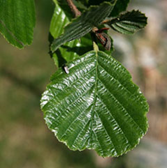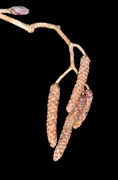(Alnus glutinosa (L.) Gaertn.)
Family: Birch Family (Betulaceae)
Native Range: Europe, West Asia
 European alder, also known as common alder or black alder is a tree that grows 40-50 ft in height. Its branches are alternate. Its leaves are simple, oval, 2 to 4 inches long, 2 to 3 inches wide, with a rounded or slightly notched tip, have a doubly serrate margin, and are dark green above, lighter below, with light-brown pubescence along the vein axils. Its bark is smooth and greenish-brown when young, and becomes dark gray and furrowed as the tree matures. Buds are purplish-brown.
European alder, also known as common alder or black alder is a tree that grows 40-50 ft in height. Its branches are alternate. Its leaves are simple, oval, 2 to 4 inches long, 2 to 3 inches wide, with a rounded or slightly notched tip, have a doubly serrate margin, and are dark green above, lighter below, with light-brown pubescence along the vein axils. Its bark is smooth and greenish-brown when young, and becomes dark gray and furrowed as the tree matures. Buds are purplish-brown.
Reproductive/Dispersal MethodsEuropean Alderis monoecious (both male & female parts are present on the same tree). Male parts are slender, reddish-brown catkins (1 to 1 1/2 inch long), much longer when shedding pollen; female parts are small (1/6 inch) reddish-brown, cone-like catkins in clusters near branch tips. It is primarily a wind-dispersed species (short-distances, 200 feet max), although it can also be water-dispersed as seeds float.
Similar Species
 Speckled or gray alder (Alnus incana), smooth or hazel alder (Alnus serrulata) and green alder (Alnus viridis), all native to North America.
Speckled or gray alder (Alnus incana), smooth or hazel alder (Alnus serrulata) and green alder (Alnus viridis), all native to North America.
Impacts
European Alder has a symbiotic relationship with the bacteria Frankia alni, which fixes nitrogen for the plant, allowing it to thrive in poor soils. This trait, along with the plant’s ability to disperse its seeds rapidly through wind and water, results in a tendency for it to colonize wetland soils, forming large monospecific stands and displacing native plants. It has been mistakenly substituted for the native speckled alder in wetland restoration plantings.
Distribution
European alder is native to Europe and western Asia. It was introduced into and has now naturalized in the mid-western and northeastern United States, ranging north into Ontario and New Brunswick, Canada.
Sources and Links:
Invasive Plant Atlas of the United States – IPANE
https://www.invasiveplantatlas.org/subject.html?sub=3252
Virginia Tech- Department of Forest Resources and Environmental Conservation
http://dendro.cnre.vt.edu/dendrology/syllabus/factsheet.cfm?ID=157
University of Florida- Institute of Food & Agricultural Sciences – Environmental Horticulture- Database
http://hort.ifas.ufl.edu/database/documents/pdf/tree_fact_sheets/alnglua.pdf
Department of Conservation & Natural Resources- Invasive Plants of Pennsylvania
http://www.dcnr.state.pa.us/cs/groups/public/documents/document/dcnr_010276.pdf